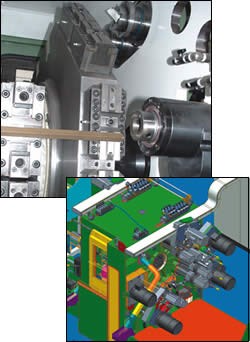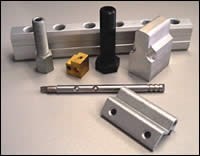Rotary Transfer Machines For Extruded Bar
To address the requirements of extruded bar applications, Italian builder Picchi, which is distributed in the United States through RBR Associates (Darien, Illinois), has developed a line of rotary transfer machines designed to handle round, hex, square, rectangular, elliptical and even complicated extruded shapes.
Selecting the correct machine for bar-fed applications involves a close study of the types of applications that will be run. Single-spindle automatics provide high-speed, high-volume production in applications for multiple-diameter or long workpieces. Multi-spindle machines reduce production times but, with up to eight spindles, require more in-depth setups. Both machines, though, require rotation of the workpiece for cutting, which can create added complications when dealing with extruded barstock.
To address the requirements of extruded bar applications, Italian builder Picchi, which is distributed in the United States through RBR Associates (Darien, Illinois), has developed a line of rotary transfer machines designed to handle round, hex, square, rectangular, elliptical and even complicated extruded shapes. In the past, this type of equipment was known mainly for high-volume and dedicated operations. Now, because all slides and stations use full CNC control, and there are up to four axes per station (Z, X, Y and U), a total change-over can be done in as little as 4 hours (versus as much as a 2-day setup on a multi-spindle).
With the vertical configuration of the table, barstock is fed in and, in the first operation, a self-centering two-jaw chuck grabs the bar, and it is then cut off with a solid carbide saw. The bar never rotates, so whip and vibration from the bar are not issues. This design also eliminates the tool performance limitations brought by multi-spindle machines that require spindles to rotate at the same (and typically slower) rpm. The transfer machine allows every unit to run at the optimal speed for the specific operation, targeting shorter cycle times, better finishes and longer tool life.
The machine can handle barstock up to 40 feet in length, as well as coil stock or hot-rolled material. The length is dictated only by the loader’s capabilities. Longer bar length allows for fewer remnants, and less operator involvement is required with fewer bar changes. The machine is particularly suited to handle extruded shapes or hex stock with an envelope diameter of as much as 6 inches.
Once the bar is fed, tool spindles address the workpiece on as many as three sides at one time. The machine allows between four and 12 stations (as many as 30 spindles and 96 axes) for machining parts between 0.5 inch and 3 inches. After the initial cutoff station, spindles at each station are lined up at opposite ends of the workpiece to allow machining of both ends of the part simultaneously. Drilling, milling, boring and other operations can be performed throughout the cycle. The machine allows the capability to mount a U-axis head—a boring or turning head that has both X and Z axes.
On a typical bar machine with subspindle capabilities, the part needs to be transferred from one spindle to the other. The Picchi rotary transfer machine can potentially hold tighter tolerances in many cases because both ends are machined simultaneously. With X, Y and Z travel, both spindles can be used at any station.
After initial machining at a station, some OD work remains because the center area of the workpiece where it was being held has not yet been machined. One or both spindles can come in and grab the part in a chuck, a collet arrangement or an expanding mandrel on the ID, open the chuck jaws and move the part out in the Y axis. One of the spindles that is running perpendicular can be used to do single-point turning of the part, either in a two- or four-axis configuration.
At any time during the cycle, cross-slide milling and cross-hole drilling operations can be performed. The part is lifted out, indexed and reclamped to allow access to multiple faces. The workpiece can be machined from six faces in one operation and dropped off complete. For simple parts such as nuts, a rotary transfer machine can be designed for completing two parts per index. Index time is typically 0.8 seconds from station to station. Dual bar loaders supply the machine, and a rotary table with double jaws combine to provide almost twice the production using only the floor space (footprint) of a single machine.
Many multi-spindle lathes use oil as coolant. The rotary transfer machine can use more environmentally friendly, water-based coolants, thus providing another advantage. The less-expensive coolant washes off of the machined parts more easily and more economically than oil. This additional benefit allows rotary transfer end-users to minimize their cost per part produced.
The advantages the rotary transfer machine brings make it a viable option for extruded bar applications. It is important that each specific application be evaluated in detail, but when a new machine is needed for barstock work, this is a possibility that should be reviewed.
Related Content
CNC Rotary Transfer Machine Features Ballscrew Electromechanical Tooling Units
A CNC rotary transfer machine, a newly developed machine platform, is said to offer high rigidity, flexibility and accuracy for a range of high-volume, precision-machining applications.
Read MorePrecision Machining Technology Review: August 2024
Production Machining’s August 2024 technology showcase includes some of the latest technology from SW North America, Tsugami, Siemens, Select Manufacturing Technologies, Hurco and ECI Software Solutions — all on display at IMTS 2024.
Read MoreHigh-Production Multitasking Becoming More Flexible
Rotary transfer machines remain well-suited for high-volume production, but are now more accommodating to smaller batch sizes.
Read MoreMoen’s Flowing Success with Rotary Transfer Technology
The popular faucet manufacturer has adopted new CNC rotary transfer equipment to produce valves for its new generation of Widespread faucets.
Read MoreRead Next
Pinning Down Production Clinches Significant Savings
Rotary transfer machines have allowed this shop to capitalize on single-operation capabilities to increase production, cut leadtimes and save manufacturing costs.
Read MoreBoosting Part-making Efficiency With Rotary Transfer
This rotary transfer machine enabled this shop to increase efficiency and cut the part price by 20 percent.
Read MoreDo You Have Single Points of Failure?
Plans need to be in place before a catastrophic event occurs.
Read More


.jpg;maxWidth=150;quality=70)

.jpg;width=700;quality=80)












.jpg;maxWidth=300;quality=90)





.jpg;maxWidth=400;quality=70)

